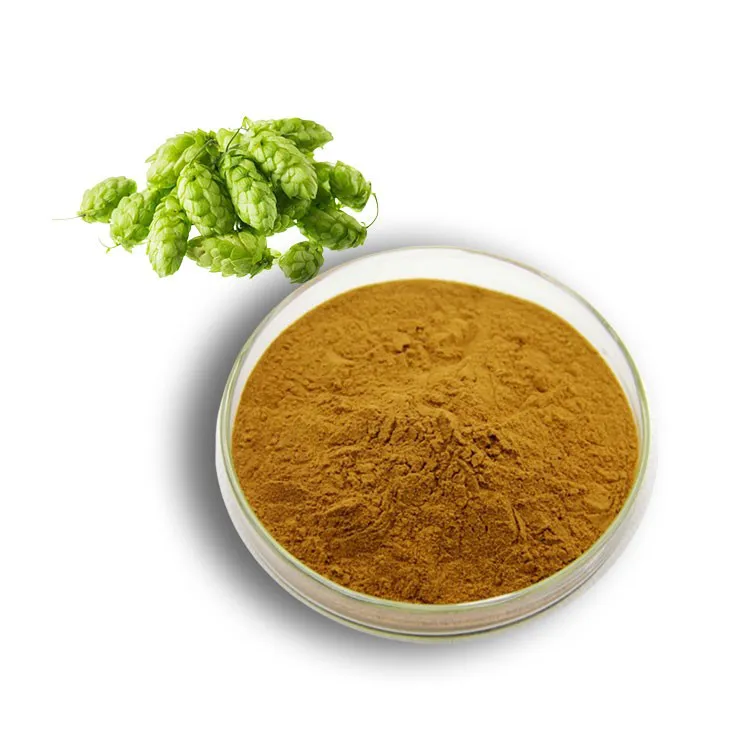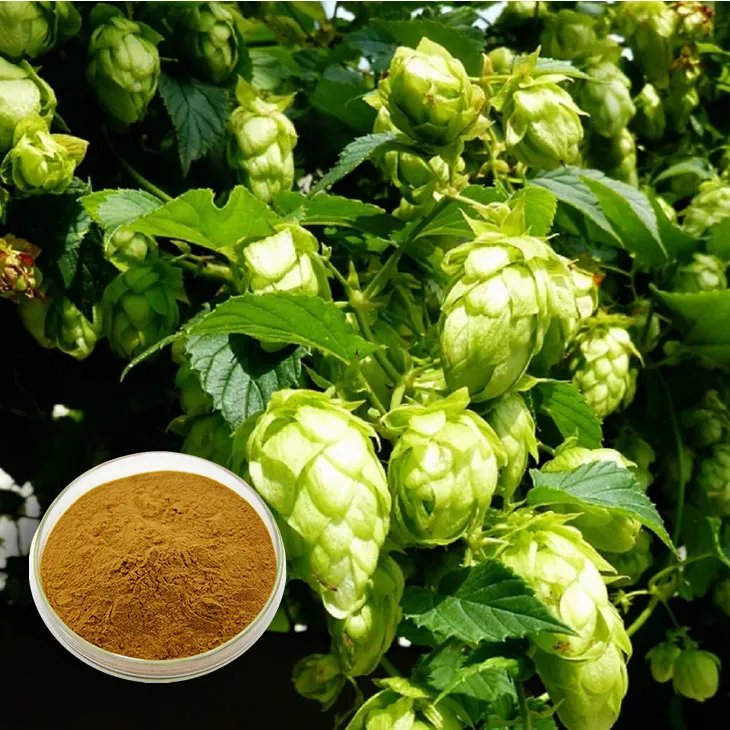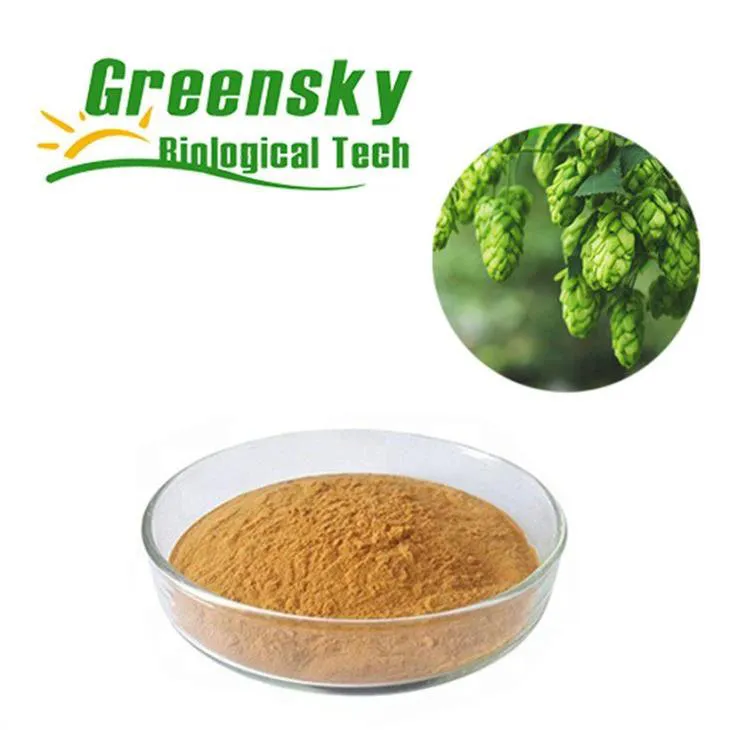- 0086-571-85302990
- sales@greenskybio.com
The process of extracting hops flavonoids from hops extracts.
2024-11-26

1. Introduction to Hops Extracts
Hops Extracts are complex mixtures obtained from the female flowers of the hop plant (Humulus lupulus). These extracts are rich in a variety of compounds, including flavonoids. Flavonoids are a class of polyphenolic compounds that have attracted significant attention due to their potential health benefits and their role in the flavor and stability of beer. Hops Extracts contain different types of flavonoids, such as xanthohumol, which is one of the most studied flavonoids in hops.

2. Extraction Techniques
2.1 Solvent Extraction
Solvent extraction is one of the most traditional methods for extracting flavonoids from hops extracts.
- Advantages:
- It is relatively simple and cost - effective. Common solvents such as ethanol and methanol can be used. Ethanol, in particular, is preferred in the food and beverage industry as it is relatively safe for human consumption at low concentrations.
- It can extract a wide range of flavonoids with different polarities depending on the solvent chosen. For example, polar solvents are good at extracting more polar flavonoids, while non - polar solvents can target less polar compounds.
- Limitations:
- The extraction process may be time - consuming, especially when using solvents with lower solubility or diffusivity. For example, if a less volatile and more viscous solvent is used, it may take longer for the solvent to penetrate the hops extract matrix and dissolve the flavonoids.
- There may be issues with solvent residues in the final product. Residual solvents can be harmful if they exceed certain limits, especially in products intended for human consumption such as dietary supplements or functional foods.
2.2 Supercritical Fluid Extraction (SFE)
Supercritical fluid extraction has emerged as a modern and more efficient technique.
- Advantages:
- Supercritical carbon dioxide (CO₂) is the most commonly used supercritical fluid in this process. It has a relatively low critical temperature (31.1°C) and pressure (73.8 bar), which means that it can operate under relatively mild conditions compared to some other extraction methods. This helps to preserve the integrity of the flavonoids, reducing the risk of degradation.
- It offers high selectivity. By adjusting the pressure and temperature, the solubility of different components in the hops extract can be controlled. This allows for the selective extraction of flavonoids, minimizing the extraction of unwanted compounds.
- There is no solvent residue in the final product as CO₂ is a gas at normal conditions and can be easily removed from the extract.
- Limitations:
- The equipment for supercritical fluid extraction is relatively expensive, which can limit its widespread use, especially for small - scale operations. The high - pressure vessels and associated control systems require significant capital investment.
- The process requires precise control of pressure and temperature. Small variations in these parameters can affect the extraction efficiency and selectivity. Therefore, skilled operators and sophisticated monitoring systems are needed.
2.3 Microwave - Assisted Extraction (MAE)
Microwave - assisted extraction is another innovative technique.
- Advantages:
- It significantly reduces the extraction time. Microwaves can directly heat the hops extract - solvent mixture, increasing the mass transfer rate. This is because microwaves cause rapid molecular motion and heating within the sample, which helps to dissolve the flavonoids more quickly into the solvent.
- It can also improve the extraction efficiency. The selective heating effect of microwaves can target the regions within the hops extract where flavonoids are located, enhancing their release into the solvent.
- Limitations:
- The extraction process needs to be carefully optimized. If the microwave power is too high, it may cause degradation of flavonoids or other components in the hops extract. On the other hand, if the power is too low, the extraction efficiency may not be significantly improved.
- There may be non - uniform heating within the sample, especially for large - scale extractions. This can lead to inconsistent extraction results across different parts of the hops extract.

3. Separation and Purification Processes
3.1 Chromatographic Separation
Chromatographic separation is a crucial step in obtaining pure flavonoids.
- High - Performance Liquid Chromatography (HPLC):
- HPLC is widely used for the separation of flavonoids from hops extracts. It can achieve high - resolution separation based on the different affinities of flavonoids to the stationary and mobile phases. For example, a reversed - phase HPLC column can be used, where the mobile phase is typically a mixture of water and an organic solvent such as acetonitrile. Different flavonoids will elute at different times depending on their chemical properties.
- It allows for the quantification of flavonoids in the extract. By using appropriate detectors such as a UV - Vis detector, the concentration of individual flavonoids can be determined, which is important for quality control and for understanding the composition of the hops extract.
- Solid - Phase Extraction (SPE):
- SPE is often used as a pre - treatment or purification step before further analysis. It can be used to remove impurities from the hops extract prior to chromatographic analysis. For example, SPE cartridges filled with appropriate sorbents can selectively retain impurities while allowing the flavonoids to pass through or be eluted under specific conditions.
- It can also be used for fractionation of flavonoids. Different types of SPE sorbents can be chosen to separate flavonoids based on their polarity or other chemical characteristics.
3.2 Precipitation
Precipitation is a simple yet effective method for purifying flavonoids.
- By adjusting the pH or adding certain reagents, flavonoids can be made to precipitate out of the solution. For example, if the pH of the solution containing flavonoids is adjusted to a specific value, some flavonoids may become less soluble and form a precipitate. This precipitate can then be separated from the supernatant by filtration or centrifugation.
- However, this method may not be as selective as chromatographic methods. There is a risk of co - precipitation of other compounds along with the flavonoids, which may require further purification steps.

4. Applications of Hops Flavonoids
The pure flavonoids obtained from hops extracts have a wide range of applications.
- In the Food and Beverage Industry:
- They can be used as natural antioxidants to extend the shelf - life of products. Flavonoids can scavenge free radicals, which are responsible for the oxidation of fats and other components in food, leading to spoilage.
- They can also contribute to the flavor and aroma of products. Some flavonoids have characteristic flavors and can enhance the overall sensory experience of the consumer.
- In the Pharmaceutical and Nutraceutical Industry:
- There is increasing evidence of their potential health benefits. For example, some hops flavonoids may have anti - inflammatory, anti - cancer, and cardioprotective properties. They can be formulated into dietary supplements or used as active ingredients in pharmaceuticals.
5. Conclusion
The extraction of hops flavonoids from hops extracts is a multi - step process that involves careful selection of extraction techniques and subsequent separation and purification steps. Each extraction method has its own advantages and limitations, and the choice depends on various factors such as cost, scale of operation, and the desired quality of the final product. The purified flavonoids have significant potential in different industries, highlighting the importance of efficient and effective extraction processes.
FAQ:
What are the main components in hops extracts?
Hops extracts mainly contain resins (such as alpha - acids and beta - acids), essential oils, and flavonoids. Flavonoids are of particular interest due to their potential health benefits and their influence on the flavor and stability of beer. Other components may also be present in smaller quantities, which can interact with the extraction process of flavonoids.
What are the traditional extraction techniques for hops flavonoids?
Traditional extraction techniques for hops flavonoids include solvent extraction. Solvent extraction often uses organic solvents like ethanol or methanol. The advantage of this method is its simplicity and relatively low cost. However, it has limitations. For example, it may require a large amount of solvent, and there could be issues with solvent residues in the final product. Also, the extraction efficiency may not be as high as some modern techniques.
What are the modern extraction techniques for hops flavonoids?
Modern extraction techniques for hops flavonoids include supercritical fluid extraction (SFE), especially with carbon dioxide as the supercritical fluid. SFE has several advantages. It is a clean technology as carbon dioxide is non - toxic, non - flammable, and leaves no residue. It also offers high selectivity and extraction efficiency. However, the equipment for SFE is relatively expensive. Another modern technique is microwave - assisted extraction, which can significantly reduce extraction time and improve extraction efficiency compared to traditional methods.
Why is separation and purification important in the extraction of hops flavonoids?
Separation and purification are important in the extraction of hops flavonoids because the initial extract contains a mixture of various compounds. Flavonoids need to be separated from other substances such as resins and essential oils to obtain a pure product. Pure flavonoids are required for accurate research on their properties, for use in high - quality beer production to ensure consistent flavor and quality, and for potential applications in the pharmaceutical and nutraceutical industries.
What factors can affect the extraction efficiency of hops flavonoids?
Several factors can affect the extraction efficiency of hops flavonoids. The type of extraction solvent or fluid used is crucial. For example, different solvents have different solubilities for flavonoids. The extraction temperature and pressure also play important roles. Higher temperatures may increase the solubility of flavonoids in some cases, but it may also cause degradation of some compounds. In supercritical fluid extraction, pressure affects the density of the supercritical fluid, which in turn affects its extraction ability. The particle size of the hops extracts can also influence the extraction efficiency. Smaller particle sizes generally offer a larger surface area for extraction, resulting in higher efficiency.
Related literature
- Extraction and Characterization of Flavonoids from Hops: A Review"
- "Optimization of Hops Flavonoids Extraction: Recent Advances and Future Perspectives"
- "Hops Flavonoids: Properties, Extraction, and Applications in the Food and Pharmaceutical Industries"
- ▶ Hesperidin
- ▶ citrus bioflavonoids
- ▶ plant extract
- ▶ lycopene
- ▶ Diosmin
- ▶ Grape seed extract
- ▶ Sea buckthorn Juice Powder
- ▶ Beetroot powder
- ▶ Hops Extract
- ▶ Artichoke Extract
- ▶ Reishi mushroom extract
- ▶ Astaxanthin
- ▶ Green Tea Extract
- ▶ Curcumin Extract
- ▶ Horse Chestnut Extract
- ▶ Other Problems
- ▶ Boswellia Serrata Extract
- ▶ Resveratrol Extract
- ▶ Marigold Extract
- ▶ Grape Leaf Extract
- ▶ blog3
- ▶ blog4
-
Mulberry Extract Suppliers.
2024-11-26
-
Active components in aguaje extract.
2024-11-26
-
Standard - process cocoa extract.
2024-11-26
-
Organic Saw Palmetto Extract Powder Factory.
2024-11-26
-
Suppliers of Organic Açai Extract Powder.
2024-11-26
-
Extraction process of black pepper extract.
2024-11-26
-
Wholesale L - Tyrosine Suppliers.
2024-11-26
-
The best milk thistle extract in 2024.
2024-11-26
-
Dandelion Root Extract
2024-11-26
-
Astaxanthin
2024-11-26
-
Senna Leaf Extract
2024-11-26
-
Withania Somnifera Extract
2024-11-26
-
Horse Chestnut Extract
2024-11-26
-
Baicalin
2024-11-26
-
Curcumin
2024-11-26
-
Selenium yeast
2024-11-26
-
Mango flavored powder
2024-11-26
-
Hawthorn powder
2024-11-26





















